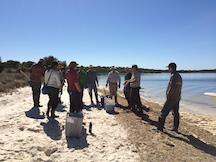|
The sun shone upon ‘Team Pepper Busters’ on Sunday February 8 as University of Florida Professor Jack Putz and his Plant Ecology class took up loppers and tackled a recurring stand of Brazilian Pepper tree on the eastern sandpoint of Seahorse Key. Led by Vic Doig from the U.S. Fish and Wildlife Services and Roger (aka “King” Pepper Buster) McDaniels from Friends of the Refuge group, the volunteers spent a couple hours pulling small plants and cutting and spraying larger plants on the east end of Seahorse Key. According to Vic, Seahorse Key was treated by the U.S. Fish and Wildlife Service several years ago. While this intervention was very successful, follow-up efforts such as this are critical to help control recurring growth.
The Brazilian Pepper tree (Schinus terebinthifolius) is native to Argentina, Paraguay, and Brazil. It was introduced to Florida in the mid-1800’s for use as an ornamental plant. Part of the family Anacardiaceae, the pepper-tree counts among its relatives poison ivy, poison oak, and poison sumac. Levy County is thought to represent the northern edge of Brazilian pepper tree. Many native Florida plant communities such as hammocks, pinelands and mangrove forests are often invaded and dominated by Brazilian pepper tree. For the past few years, the Friends of the Refuges has been assisting the U.S. Fish and Wildlife Service in efforts to control and manage this invasive plant. Thanks to Donna and John Thalacker who alerted us to this stand of Brazilian Pepper-tree.
0 Comments
Leave a Reply. |
Archives
April 2024
|

